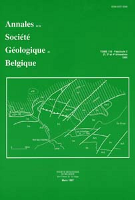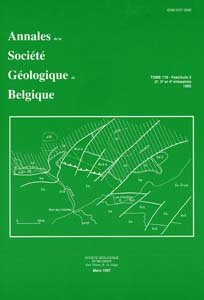- Home
- Volume 116 (1993)
- Fascicule 2 - Carboniferous biostratigraphy
- Late Famennian miospore assemblages from the Bergisch Gladbach - Paffrath Syncline, Rhenish Slate Mountains, Germany
View(s): 432 (6 ULiège)
Download(s): 836 (17 ULiège)
Late Famennian miospore assemblages from the Bergisch Gladbach - Paffrath Syncline, Rhenish Slate Mountains, Germany

Résumé
Assemblages de miospores du Famennien tardif du Synclinal de Paffrath-Bergisch Gladbach, Massif Schisteux Rhénan, Allemagne. A l'occasion d'une analyse palynologique de routine de sédiments dévoniens du Synclinal de Paffrath-Bergisch Gladbach, Massif Schisteux Rhénan, des couches marines du Famennien tardif, inconnues jusqu'ici dans cette région, ont été identifiées. L'indice d'altération thermale (TAI de 2 à 2+) est remarquablement faible comparé à d'autres sédiments des régions ardenno-rhénanes, suggérant que l'ensemble n'a jamais été enfoui profondément. Grâce à cette maturité thermale faible, la conservation des miospores est très bonne à excellente. Les assemblages de miospores sont riches et diversifiés. Les espèces du complexe Diducites sont particulièrement abondantes. D'autres espèces stratigraphiquement significatives sont Cyrtospora cristifera, Grandispora comuta, Raistrickia variabilis, et Retispora lepidophyta. La dernière espèce est un marqueur pratiquement mondial pour le Famennien tardif. La présence de Grandispora echinata et Knoxisporites literatus est encore douteuse et, en conséquence, les assemblages ont été attribués à la Zone d'Oppel LV. Les diamètres relativement grands de l'exoexine de Retispora lepidophyta indiquent une position proche de la base de la Zone d'Oppel LV. Les sédiments immédiatement plus anciens connus dans le synclinal sont d'âge Néhdénien inférieur. On ne sait pas encore si des sédiments Néhdénien supérieur, Hembergien et Dasbergien sont présents dans cette région.
Abstract
During routine palynological analysis of Devonian sediments of the Bergisch Gladbach-Paffrath Syncline, Rhenish Slate Mountains, late Famennian marine strata hitherto unknown in this region have been recognized. The thermal alteration index (TAI of 2 to 2+) is remarkably low compared to other Upper Devonian sediments in the Ardenne-Rhenish area, indicating that the settings were never deeply buried. Due to the low thermal maturity the miospore preservation is very good to excellent. The miospore assemblages are rich and diverse in composition. Species of the Diducites complex are particularly abundant. Other stratigraphically significant species are Cyrtospora cristifera, Grandispora cornuta, Raistrickia variabilis, and Retispora lepidophyta. The latter species is a near world-wide marker for the late Famennian. The occurrence of Grandispora echinata and Knoxisporites litera-tus is still doubtful and hence, the assemblages have been assigned to the Oppel Zone LV. The rather large diameter of the exoexine of Retispora lepidophyta signifies a position close to the base of the Oppel Zone LV. The next older sediments known in the syncline are of lower Nehdenian age. It is still doubtful whether upper Nehdenian, Hembergian and Dasbergian sediments are present in this area.






